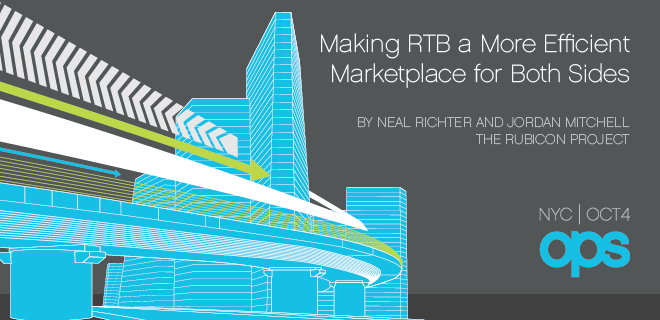
The RTB marketplace is not yet operating as a truly efficient market with equal benefit to both sides. This is due to basic economics: Supply exceeds demand, and auction-based pricing combined with low bid density results in a market rife with arbitrage.
Buyers are accustomed to drawing from a large commoditized pool of inventory, with the basis for valuation by the buy-side entirely opaque to the sell-side, and the majority of bids well below each bidder’s “true value.” As a result, publishers are reluctant to put premium inventory into the market without mechanisms to prevent auction prices from clearing at a fraction of the actual market value.
In order for RTB to evolve, there must be balance in the market. Here are a few things that will help establish a more liquid and efficient marketplace that can flourish to the benefit of all parties.
Multi-Bid Responses From DSPs
When a DSP presents a single advertiser bid they have truncated the demand for that impression. Because most DSPs work on behalf of multiple advertisers and agency trading desks, each with independent budgets, this activity fits the standard definition of a bidding ring.
A bidding ring is when a group of bidders agree to not compete with each other in the same auction, and this is known to cause seller revenue problems within second price auctions. Single bid responses constrain market growth – they significantly decrease bid density and breadth of demand for the sell-side, and deny buy-side access to a tremendous amount of inventory. For the auction to be truly fair, all bidders with independent budgets must be represented as individual bidders within each auction.
To that end, the IAB OpenRTB Consortium added multi-bid responses to version 2.0 of the standard. Working with any DSP or trading desk that would like to show a fuller and richer picture of its demand to publishers will start a virtuous cycle of higher quality inventory being released to RTB, better ROI for advertisers and higher clearing prices for publishers.
Normalized Inventory
Auctions work more efficiently when the items being traded are described consistently and accurately, across both buyer and seller. We believe DSPs need to work with publishers and allow transparency and control over how their inventory is organized in the buy-side system.
At the moment this is a black box and from our analysis of buying patterns it appears that most DSPs are simply buying by URL. They’re not able to consider how publishers are organizing their inventory into slots, channels and micro-marketplaces, so many DSPs are using custom or third-party contextualization APIs to categorize inventory for targeting. This is often damaging to publishers, as they are typically not deeply involved in how their inventory is contextualized.
This must change. The goal is to normalize the catalog of inventory and describe how the publisher segments it. The IAB OpenRTB Consortium is working to create an Inventory Description API, and we encourage all DSPs to adopt this standard as it becomes available.
Reserve Pricing (Price Floors)
Reserve prices are a standard mechanism in auction theory. They are necessary to preserve the inherent value of publisher inventory, and prevent price erosion in an illiquid, low-priced marketplace. Impressions are not identical grains of rice; they should not have the same reserve, as the valuation of inventory across RTB is enormously varied and complex.
There are hundreds of different factors considered by the buy-side in their bidding algorithms, all of which fluctuate over time. Given that complexity, it’s far too effort-intensive to be done manually (unless a publisher merely wishes to set all reserve prices to rate card). Indeed, machines, data and algorithms must derive those reserve prices.
We understand algorithmically derived reserve pricing causes concern with some DSPs, particularly those whose margin is directly affected. However, DSPs use data and algorithms to make bidding decisions on a per impression basis, all of which is opaque to publishers. It’s fair and reasonable for publishers to have the option to use data and algorithms to help set price floors to protect the value of their inventory.
Open Research Problems
There has been a resurgence of active academic research within “economics” and “computational advertising” circles on auction theory. A few tweaked auction mechanisms have been proposed and studied for Internet advertising. Other work discusses the technical issues induced by the inherent differences between the generalized second-price auction in search advertising versus display advertising.
Display advertising with RTB is more complex than search advertising. The units offered for sale have a higher dimensionality than a phrase within a search landing page (or common stocks and commodities on a financial exchange). Campaigns come and go with rapid pace, new audiences are created with data, prices change, budgets shift, experimental campaigns are exploring for new inventory, private data arbitrage is happening. There are many open problems and questions to examine.
We’re all trying to grow this marketplace, and we agree that bidirectional transparency coupled with premium quality inventory and strong liquidity is required to do so. Algorithms will automate this trading activity, on both sides.
The objective is to allow marketers access to high-quality impressions while allowing publishers to monetize their best inventory at fair rates. When we do this together as technology platforms, we’ll develop a liquid and efficient marketplace that serves both sides.
 |
Macro-level changes are coming, and you can sieze the opportunities that follow at OPS NY. This event will bring together digital advertising leaders and ops professionals to discuss a rapidly evolving landscape and develop strategies for monetization. Register today for OPS NY which will be held Oct. 4, 2012. |
 Jordan Mitchell is Vice President, Product at the Rubicon Project, and came to the company through the acquisition of Others Online, Inc. in May 2009 where he was Founder/CEO. Jordan lives in the Seattle area, has been working within the field of online advertising technology since 2003, and has a particular interest in big data and related product strategies. When not working, Jordan enjoys outdoor activities with his family.
Jordan Mitchell is Vice President, Product at the Rubicon Project, and came to the company through the acquisition of Others Online, Inc. in May 2009 where he was Founder/CEO. Jordan lives in the Seattle area, has been working within the field of online advertising technology since 2003, and has a particular interest in big data and related product strategies. When not working, Jordan enjoys outdoor activities with his family.